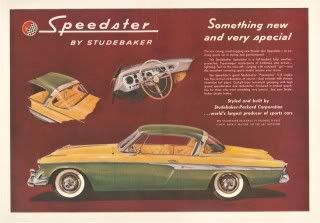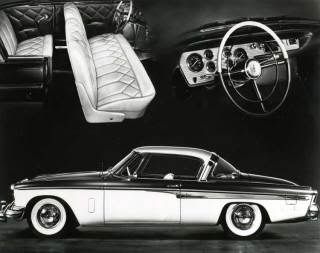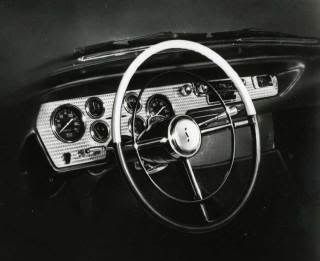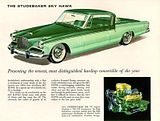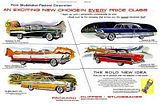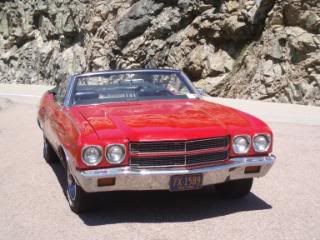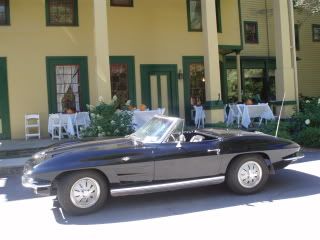Studebaker’s New V-8
Triumph and tragedy, An Independent Automobile Company’s quest to survive a change in it’s reality.
By: Murray D. Stahl
(Proud Owner of a Studebaker Speedster )
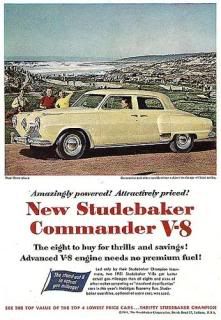
In 1951 the Cadillac and Oldsmobile overhead valve V-8s were barely two years old. The handwriting was on the wall; an automobile company could only prosper with a modern overhead valve V-8 engine. Studebaker had been contemplating a V-8 for years. In fact after the war the new “coming or going” Studes had frames designed to accept a front or rear mounted power plant either V-8 or pancake 6. (D) (E)
It doesn’t take too much of a leap of faith to surmise that Studebaker began thinking of a V-8 as a marketing advantage right around 1948. It had to be a wakeup call when the upstart Kaiser-Frazer outsold Studebaker for a few months in 48-49 even though Studebaker sported a newly designed body style.
It was during this period that Kaiser had a dedicated team working on a V-8 headed by Paul Bastian with Harold Bullard and David Potter. They were far along on the design when the plug was pulled due to poor cash flow. It’s known that Mr. Potter presented his ideas to Studebaker. Today we would call the use of good designs found in various competitors engines “best practices” and there is no doubt that Studebaker built a stout V-8 design by picking and choosing from those best ideas. (K) (G)
Even then the Independents were fighting over a dwindling piece of the market share pie. (K) Studebaker probably saw a large portion of those K-F sales as coming out of their totals. The post-war market where you could sell anything you built was ending and all the independent automobile companies were faced with the same problem, succinctly analyzed by Bill Williams in a 1973 Special Interest Autos article:
“It costs as much for a small company to retool a new car as it does a big one. Chevy or Ford though can amortize that tooling over, say, a million cars while a company like K-F is lucky to produce a tenth of that. Now it’s true that it costs less to tool for a 100,000 car run than for a million car run but not enough less to make the lower run competitive.
Similarly, it costs K-F exactly the same to buy a one-page ad in Life as it did one of the big three. Again (they) could spread this per-car ad cost over perhaps a million cars, so for each car the ad costs, lets say one cent. But for a 100,000 car run that same ad cost K-F ten cents per car.”
The same daunting cost threshold faced Studebaker and all of the other independents. It’s not documented but it seems reasonable to assume that Studebaker was well aware of this cost-disadvantage versus the big three and saw their salvation as being a bolder kind of full line manufacturer. This would certainly explain their very bold, controversial and often-beautiful post-war car designs. It also fostered thrift; the 1953 bumpers were still being used during Studebaker’s end game in the mid-sixties; Chevy had 9 specific bumpers in the same period. They pioneered sliding roof designs and championed the use of Superchargers. The age old question, “Does adversity foster innovation and Excellence” comes to mind. There's no doubt they put themselves into an untenable position by not addressing the fact that their overall costs per vehicle were much higher than their competitors. High labor cost, sliding sales and an inefficient manufacturing plant constituted a perfect storm. High cost equaled low sales and profits that severely constricted funds for redesign or innovation. This circle of problems eventually doomed Studebaker even though their design talent fought bravely to break out of it. Studebaker's break-even point was hovering around 282,000 vehicles sold in a year.
Studebaker was a “full-line” Automobile producer with a miniscule market share. Their competitors enjoyed market shares as high as 55% while theirs was 4% at its high-point in 1950, sinking fast from there to well under 1% in 1954. I suppose Studebaker management could have thought that they could overcome their inherent, structural disadvantages and become a large enough company to survive and prosper but that only shows a triumph of hope over reality.
As the new V-8 was introduced Studebaker management was congratulating themselves on 1950 sales of 334,554 vehicles. It was a high water mark. Soon the company would be hanging on by their proverbial fingernails selling 82,000 cars in 54. A 66% drop in three years despite a “state of the art” engine and redesigned automobiles. The new engine was a triumph hitting all its design and quality benchmarks but it could not be the silver bullet Studebaker needed. In my opinion their basic business model was faulty.
For Studebaker to market a V-8 in 1951 was a remarkable achievement. Little Studebaker was the only independent to market a V-8 prior to1955, and even this great little engine was designed before anyone realized what a big deal the horsepower race was going to be. A case can be made that Hudson and Kaiser failed due to the lack of a “Modern” V-8. (K) Packard was late to the V-8 party and it certainly contributed to their demise. Nash, aka American Motors lengthened their life and shined themselves up for a sale with their own V-8.
The new engine offered more power and the additional benefit of greater economy as well. In the Mobilgas Economy Run of 1951 a V-8-powered Commander with overdrive managed a 28-mpg average from Los Angeles to the Grand Canyon via Death Valley. That beat the 1950 L-head Six Commander's mileage by more than four miles per gallon. As you look at the EPA figures for our modern full size cars take note of how few can match this fuel economy 50 plus years later.
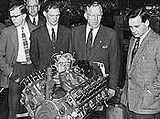
Korean war restrictions and an abbreviated model year due to labor problems meant Studebaker couldn't approach its 1950 sales record. Production in 51 dropped to 268,565 cars, but V-8 Commander sales were a far greater proportion of overall sales than previously: In 1950 Commander sales were just 21 percent of sales, while in 1951 they more than doubled to 46 percent of the total. Thanks to this sales success, plus war production making trucks for the use of the military Studebaker rolled into 1952, it’s centennial, looking proud and strong due in no small extent to the new V-8.
The first Studebaker V-8 started out at a modest 120HP; four years later they gained 46% more power to 185HP on the 55 Speedster. This was accomplished without raising the compression ratio; they did it by tweaking their over-square engine design, slightly expanding the bore, shortening the stroke. Adding a four-barrel Carburetor and split manifold exhaust. (D) An analysis shows that a typical long stroke engines pistons travel 40-odd miles up and down for every 100 miles of automobile travel. In a modern short-stroke engine like the new Studebaker each piston will cover only 29 miles over the same distance. (H) Everything else being equal the less distance a piston travels, the less wear it generates.
When the stroke is shortened the incoming air-fuel mixture has a good deal less velocity through the valve ports; that lengthens valve life and reduces engine noise. In 1955 the little engine that could went from 232 Cubic inch displacement to 259 and boasted a better power to weight ratio than any US automobile save the Chrysler New Yorker Deluxe. It would eventually reach it’s zenith at 289 cubic inches. (H) (E) (J)
The application of forged cranks, rods and pistons along with the high alloy cast blocks promised durability not usual in a low priced car. The use of timing gears instead of chains cost more but assured trouble free, high mileage engines. The designed in full pressure oiling gave the engine state of the art lubrication. “All Studebaker blocks were seasoned; they were cast and painted to inhibit rust then set outside for two cold South Bend winters.” (C) This allowed the block to pre-stress before machining. It was this “seasoning” that held their crankshaft and cylinder bores true, free of stress and was a major reason for high mileage longevity. It was a very unusual practice in all but high-end vehicle engines.
(B) (C)
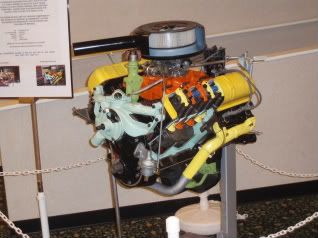
Hop-up magazine in their 1953 manual of new engines by Gene Jaderquist said that the new Studebaker V-8 so closely follows the Cadillac V-8 in it’s general design and appearance that with the valve covers removed only an expert could tell them apart. All the outside dimensions are within 3/8 inch of each other and the intake manifolds are interchangeable. The valving is similar but for a ¼ inch extra length on the Studebaker. On the Studebaker their rod and main bearing area exceeded the Cadillac by 22% and the little Studebaker V-8 made .515 HP per cube to the Caddy’s .484. (A) Studebaker was the only early adopter of a
V-8 to use solid lifters. With a modified cam they reached 7000RPM in testing with these lifters. (O)
Studebaker had hoped to reduce cost by shortening the engine footprint, which would allow a shorter and lighter car. They were successful; the V-8 powered car came in at 215 pounds lighter and 10 inches shorter than the six cylinders it replaced. Due to the extraordinary cost of developing a new engine from scratch and tooling it for production the design had to allow for the near certainty of much higher Compression and higher cylinder pressures. Their design gave the new engine a lower end tough enough to handle any loads the foreseeable future would likely demand. (B)
Studebaker engineers had planned for compression increases by securing each cylinder Head with 18 bolts; six bolts surrounded each cylinder. This allowed for extraordinary head sealing that virtually eliminated Cylinder head leakage even when subject to the pounding of a supercharger or turbine. To put it in perspective; “late model Mopar, Ford small block and Y-blocks have 10 head bolts, a Buick V-6 (stage ll) has 14.” The very durable, long-lived, Chevy small block V-8 has 17 bolts to Studebaker’s 18. (E)
A small engine to start and it stayed small but only the Chrysler, using a very expensive to build hemispherical head technology, produced more HP per cubic inch. (E)
The trend in fifties engine design was to thin wall casting however Studebaker once again took a different path. They elected to go with a heavy wall casting that would accept large overbores. Few automobile manufactures could boast a possible .187-inch overbore. Even with that enormous overage the castings piston walls remained about as thick as a Chevy V-8 thin-wall block at standard. (C)
In a fit of hyperbole, Tom McCahill, the dean of auto test drivers called the little engine fitted to a relatively light body “nitroglycerine stuff.” Perhaps he was just peering into the future. The little mouse-motor began life as a 120HP weakling but grew to a 335HP production engine by the end of its life. (L) A definite tribute to the robust design. Even Consumer Reports when road testing the new engine praised it for running “quietly and smoothly.” It’s unusual that they praised an engine during this era. (N)
The new 1951 Studebaker V-8 had a built in durability beyond its rather bland, early vitals:
Type: OHV V-8, Seasoned iron block, iron headsDisplacement: 232.6 cubic inchesBore x stroke: 3.38 x 3.25
Solid Lifter valve train
18 Bolt Heads, 6 bolts/cylinder
Forged crank, rods and pistons
Chromed piston ringsCompression ratio: 7.0:1Horsepower @ rpm: 120 @ 4,000Torque @ rpm: 190-lbs.ft. @ 2,000Fuel delivered through a Single Stromberg two-barrel downdraft carburetor
The US automotive industry in 1951 sold 5,338,435 new cars, including the 1000 millionth. Most models were 'carry-overs' from 1950 with the customary annual facelifts. Only Kaiser-Frazer and Packard's 1951 models were entirely new. Ford and Plymouth introduced their first hardtops in a catch-up effort to match the GM hardtop convertible coup. Hardtops had become very desirable fashionably resembling convertible coupes except that the tops were metal and could not be folded down.
The little Studebaker V-8 came to market during these most difficult years for America's independent auto manufacturers. While the biggest problem was most likely Henry Ford II glutting the market with new cars in a vain effort to catch and pass Chevrolet. The Ford sales blitz put enormous pressure on the smaller companies unable to absorb large losses to sell cars. The old proverb, “when elephants dance the mice tremble, comes to mind. Another problem was the market's embrace of the V-8 engine, which required costly tooling and design changes beyond the capacity of most of the smaller automakers. Studebaker was the first independent to come out with a V-8 and even this great little engine was designed before anyone realized what a big deal the horsepower race was going to be. (F)
Proud Moments at the birth of their V-8
In the end this small, century old company showed great daring when it bought out the very first OHV V-8 made by an independent automaker. The proof of their determination was the high quality design for their new V-8. This was quickly born out as the new engine found it’s way into 1951 Commanders. There was only a single, small recall and total warrantee costs were appreciably lower than the decades old six it replaced. A very early spate of cam failures was quickly addressed and did not dim customer confidence.
Photo taken at the Studebaker International meet held in September 2008 at Lancaster Pa. by author
The innovative, lets try anything, spirit Studebaker fostered sometimes veered off course. Borg Warner made Studebaker automatic transmissions and along with Studebaker designed a mechanical power steering unit. It was powered through a belt and featured a series of clutches. (M) While touted as simpler than every other manufacturers hydraulic power steering it was discontinued mid-year 1953. The real world found it very noisy and impossibly complex. Road tests late into the model year still talked about it’s unavailability so it seems it only wasted design funds, not warrantee problems. It was very close to still-born. (O) To my eye it looks complex to the point of a parody of a simple design.
Once GM had dropped their small block V-8 bomb into the automobile marketplace the hoary old long stroke, low power flat-head engines everyone had in their sale brochures looked old fashioned and no amount of innovative styling risk could change that perception.
Back in the day carmakers reveled in different; why in 1930 the Cadillac division alone made a V-8 a V12 and a V16. Customer choices abounded. By 1950 General Motors was offering customers the choice of a flathead six or eight cylinder car (Pontiac); an overhead valve six (Chevrolet & GMC), an overhead valve V-8 (Cadillac & Olds), an overhead valve straight eight (Buick) and all kinds of permutations of 2, 3 or 4 speed automatic transmissions. That’s five dramatically different engine designs just at GM. Ford countered with a flathead V-8 or flathead four along with a late arrival overhead valve six. Chrysler hid their head in the sand, completely ignoring any V-8 or overhead valve configuration until 1951. They had done very well with essentially the same flathead six and eight cylinder engines for 25 years. Chrysler also hedged their bet with a semi-automatic transmission that retained a clutch pedal like it was a security blanket in a Charlie Brown cartoon. The marketplace had punished Chrysler in the thirties for an innovative and bold body design and they only seemed to shed the fear of failure with the Hemi developed concurrently with the Studebaker V-8.
These were only the major companies; independents like Packard had marketed wonderful straight, flathead sixes, eights, V12s and V16s. The Auburn, Cord, Duesenberg consortium flirted with front wheel drive and manufactured engines that are still usually considered works of art. Franklin made great air-cooled engines for their expensive cars long after conventional wisdom deemed them too noisy and suitable only for lawn mowers. Crosley and Chevrolet briefly sold “copper” engines that had a lifespan about the same duration as a fruit fly’s.
In an era when drivers routinely tinkered and repaired their vehicles people were fiercely loyal to cars and engines they were familiar with. Once you mastered a flathead the prospect of working on an overhead valve engine was daunting. Change is scary. You could peg people as “Chevy” or “Ford” guys. To my Dad anyone admitting to being a “Studebaker” guy was as far out there as a quarterback wearing a dress. He was an “Olds” guy but willing to humor friends loyal to other makes as long as they were GM makes. When my older brother opened a British sports car dealership it was like finding out his kid was a commie. In those days car ownership was like joining a religious sect except that you could argue about it and argue they did.
It was into this difficult environment that Studebaker blew into the market with its own overhead valve V-8 in 1951. The new engine displaced a diminutive 232 cubic inches while pumping out 120 horsepower. The relatively lightweight Studebaker bodies allowed this V-8 to climb quite high on the performance charts for 1951 with acceleration and top speed figures close to the Oldsmobile 88. The year preceding the new V-8 was very mixed; industry production at 8 million set a record while Studebaker production at some 334,500 units was up 9.7%. Despite the increase in sales profits only rose 1% as Studebaker settled their labor dispute with a contract that would forever haunt them. (F) Whenever revenues rise by 10% while profits only eke out a 1% increase the differential poses a problem. A case can be made that this was the start of Studebaker’s demise. Studebaker's break-even point fluttered around 282,000 vehicles sold in one year. Soon the company would be hanging on by their proverbial fingernails, selling 113,920 total vehicles in 1954. It got worse when 30% of Studebaker's big dealer network abandoned them by 1956. By 1956 sales had cratered to only 85,401 cars, by 1958 it was only 79,301 vehicles. The grim reaper could be clearly seen silhouetted on the horizon. (F) The new engine placed Studebaker in a more competitive position than the other independents but it alone could not negate their horrid cost situation and the botched launch of the new design in 1953.
The Olds and Cadillac V-8 had started an avalanche. One by one, almost every other American manufacturer brought out its own OHV V-8 engine; Chrysler and Studebaker in 1951; Lincoln in 1952; Buick and Dodge in 1953; Ford and Mercury in 1954; Chevrolet, Pontiac, Plymouth, and Packard in 1955; and even AMC in 1956. Each of those engines had its own peculiarities, but they were all in the mold of the Oldsmobile and Caddy V-8. The overhead-valve V-8 would dominate the American industry well into the 1980s, resulting in some staggeringly powerful engines whose output has only recently been surpassed.
So here it was, Studebaker had their V-8 and had just signed on to produce a line of low, swoopy, clearly gorgeous coupes in 1953 that would forever be called, “Loewy coupes”. The designers had viewed this car as a low production kind of “halo” car. It seemed that no thought had been given to just how it would look as a higher more truncated sedan. It looked small and unusual and sold poorly. One of the basic facts of automotive life is that designers love working on convertibles, coupes and sports cars; it’s up to the adult supervision to bring them back to reality. The four door family sedan was the cash cow of all “full line” automobile manufactures; it remains a mystery how the mesmering glow of the pretty coupe design had made Studebaker management lose sight of that basic business fact. A sampling of road test, new model introduction articles showed almost no interest in the sedan, they seem to be rarely even mentioned. (P) (O) (Q) They wanted an innovative, bold design to yank them from their sales doldrums but instead they piled on another layer of problems. As Stated by H.L. Mencken, “for every complex problem there is an answer that is clear, simple and wrong.”
By 1954 they had stumbled into a merger agreement with Packard that closely resembled two drowning men reaching for a single life preserver. As they merged both companies were losing fearful amounts of money struggling with disappearing sales, obsolete plants and a high cost structure.
In my opinion Studebaker’s demise could have been predicted and avoided by a more intuitive management in the early fifties. In 1950 they had money, a shiny new V-8 ready for launch and many choices for a new car design. They chose the path to continue as a “full Line” manufacturer. They were the only independent with a full line of trucks and heavy defense work. Given that, it should have been possible for management to look into the future a bit and see that the defense work would wane, the competitors could compound “economies of scale” and their labor costs were outrageous. Insight into the future to plan and react is the definition of good management. Others usually handle the day-to-day operational decisions; foresight is what management is paid for and this is where Studebaker stumbled badly.
With our benefit of hindsight we can fantasize that an early move into a high-quality, niche player situation may very well have worked. Porsche, Aston Martin, Morgan and even Avanti Motors come to mind. The key would have been recognizing the confluence of problems they would face early on. As Charles Darwin famously stated, “It is not the strongest of the species that survives, nor the most intelligent, but the one most responsive to Change.”
I can visualize (Ok dream) of a Studebaker company in the fifties that actually analyzed it’s situation and realized that it had very rarely exceeded it’s breakeven point in revenue from vehicles excluding the military business. Since 1941 an almost constant level of military vehicle contracts had propped it up. Could they possibly have thought they would always get the contracts? In my dream they decide to become a high-quality, low volume niche manufacturer, it would require them to shed truck, sedans and most of their unwieldy dealer network. It would be difficult but so was trying to market the awkward conversion of the Lowey coupe to a four-door sedan. The Avanti, Hawks and Speedster showed their design expertise was greatest in specialty, essentially niche automobiles. A breakeven point of 40 to 60 thousand highly styled, high quality autos would seem doable while an every two year cycle of complete redesign of a full product line on dwindling revenues proved to be “a bridge to far” for them. There was that brief window when they had the money. Porsche with their 911, Leyland with the Mini and the seemingly timeless Avanti show that a great design, if properly exploited, remains viable far into the future. The key seems to be “design character” that is able to transcend time. It doesn’t have to be a high-end vehicle, it just has to be true to it’s intended use. The Volkswagen beetle was designed as a high-quality, inexpensive and extremely durable automobile. It was produced virtually unchanged for many decades and became a legend. On the other side of the spectrum sits the Porsche 911; a costly, high-quality, state of the art piece of rolling art that proves that if form follows function then design continuity works. Porsche and Volkswagen didn’t tinker with the original purpose of the vehicle, enhancements were complementary to the original theme be it performance or thrift. The Gran Turismo was a wonderful effort but came to market well after the buying public had tired of the many years of Studebaker struggles. I wonder what would have been had a Sherwood Egbert and Brooks Stevens surfaced early on. They seem to have “got it.”
It’s fantasy but remember the Avanti soldered on for 30 plus years despite chronic under funding. The new V-8 was sorely needed but it certainly couldn’t solve all of Studebaker’s problems.
As this is written it appears that our remaining US auto manufacturers have fallen behind their peers in cost control and innovation forgetting the history of their own industry. The buying public in its group Knowledge is able to discern what is the better product. A sales salvation isn’t possible without having the better product. Its very sad that our current Automobile manufactures have lost sight of how to provide the overall value that their customers demand (R)
The final days of Studebaker saw some wonderful car designs created on budgets that wouldn’t fund a door handle design at GM. The Speedster, Hawks, Lark, Gran Turismo and Avanti were tributes to what I think were the best designers in Detroit. They consistently updated the aged designs and produced many timeless and distinctly different cars. Everything they worked on was based on a design at least 13 years old.
The little V-8 was able to run at 147.36 MPH for 50 Kilometers. The Supercharged Stude V-8 set 72 new USAC records IN 1962 including 118.33 MPH for 500 kilometers and a top speed of 153.48 MPH. Heady stuff for a lark. (F) (D)
Studebaker failed, as most companies do, from management failure compounded by a lack of understanding of the company’s situation. In their death throes they created milestone designs that turn heads today. The failure of Studebaker is constantly reviewed because of the recognition of what could have been. A management with vision could have made them into a niche contender, an icon. In 2008, many decades since the doors closed, the Studebaker Drivers Club (SDC) is the largest and one of the most active single Marquee clubs. That’s a great tribute to their design skill and just plane pluck.
Sources:
(A) 1953 Hop-up magazine manual of New Engines by Eugene Jaderquist and Griff Borgeesen
(B) The Studebaker V-8 engine; a presentation by E.J. Hardig, T.A. Scherger and S.W. Sparrow at the SAE Summer meting on 6-7-1951
(C) Engine Report, Studebaker V-8 by Classic Auto Restorer, February, 1997
(D) Total performance Independents by Richard Datson
(E) Studebaker Extreme Duty Engine Book by Richard Datson, (1995 edition)
(F) Studebaker, the complete history by Patrick Foster
(G) Road Test Comments on the McCulloch Supercharger, Motor Life, August 1955 article on Supercharged Speedster
(H) Popular Science, November, 1954
(J) Special Interest Autos, SIA #51, June 1979
(K) The last onslaught on Detroit by Richard M. Langworth
(L) Ultimate American Engine Data by Motorbooks
(M) Speed Age, April 1953, America’s First Motor racing Magazine
(N) Consumer Reports, March, 1955
(O) Speed Age, September, 1953
(P) Fortune Magazine, Automobile Topics, February 1953
(Q) Popular Science, February 1953
(R) The Wisdom of Crowds by James Surowiecki
